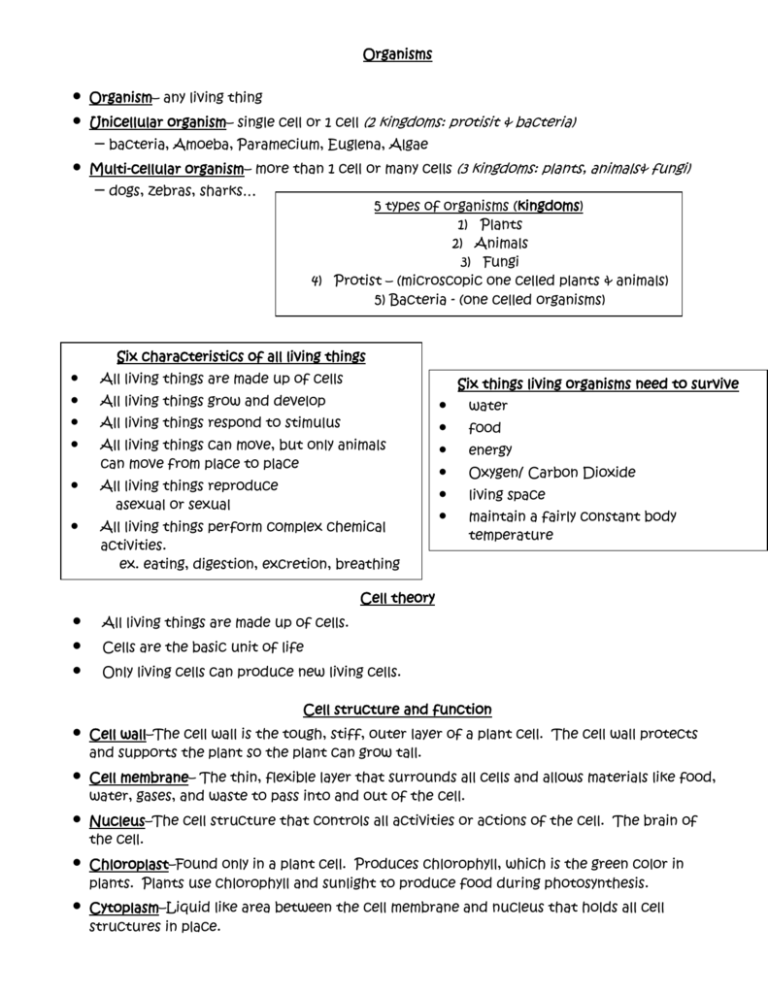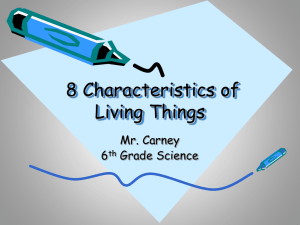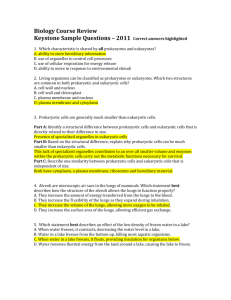Organisms, cell structures, functions & processes
advertisement

Organisms • • • Organism– any living thing Unicellular organism– single cell or 1 cell (2 kingdoms: protisit & bacteria) – bacteria, Amoeba, Paramecium, Euglena, Algae Multi-cellular organism– more than 1 cell or many cells (3 kingdoms: plants, animals& fungi) – dogs, zebras, sharks… 5 types of organisms (kingdoms) 1) Plants 2) Animals 3) Fungi 4) Protist – (microscopic one celled plants & animals) 5) Bacteria - (one celled organisms) Six characteristics of all living things • • • • All living things are made up of cells • All living things reproduce asexual or sexual • All living things perform complex chemical activities. ex. eating, digestion, excretion, breathing • • • All living things are made up of cells. Six things living organisms need to survive All living things grow and develop All living things respond to stimulus All living things can move, but only animals can move from place to place • • • • • • water food energy Oxygen/ Carbon Dioxide living space maintain a fairly constant body temperature *Homeostasis– the ability of an organism to keep conditions inside the body the same, even though conditions outside the body Cell theory change. Cells are the basic unit of life Only living cells can produce new living cells. Cell structure and function • Cell wall–The cell wall is the tough, stiff, outer layer of a plant cell. The cell wall protects and supports the plant so the plant can grow tall. • Cell membrane– The thin, flexible layer that surrounds all cells and allows materials like food, water, gases, and waste to pass into and out of the cell. • Nucleus–The cell structure that controls all activities or actions of the cell. The brain of the cell. • Chloroplast–Found only in a plant cell. Produces chlorophyll, which is the green color in plants. Plants use chlorophyll and sunlight to produce food during photosynthesis. • Cytoplasm–Liquid like area between the cell membrane and nucleus that holds all cell structures in place. Plant Cell • • • • • Cell wall Cell membrane Chloroplast Cytoplasm Nucleus • • • • Animal Cell Cell membrane Cytoplasm Nucleus Cell functions or processes that keep the cell alive: 1. Diffusion: The movement of food and gas molecules into the cell and waste products out of the cell through the cell membrane. Diffusion helps cells stay alive by moving food, gases, and other materials into the cell so the cell can change these substances into energy. Diffusion also allows the cell to remove harmful waste out of the cell that could poison the cell and the entire organism. 2. Osmosis: The movement of water into or out of the cell through the cell membrane. Osmosis keeps cells alive by moving water into the cell. Without water in the cell the cell would dry up or dehydrate which would kill the cell and the entire organism. 3. Reproduction or cell division: Cell division or mitosis is the way a cell reproduces. Cells split or divide to form a new cell that is exactly like its parent cell. Cell reproduction allows new cells to be formed and allows the organism to grow and develop. One-celled organisms form a new one celled organism when they go through cell division. Cell division helps keep the cells alive by reproducing more cells to replace dead or injured cells. Cell division lets the organism grow and develop as more cells are produced. One-celled organisms reproduce new one-celled organisms through cell division. 4. Respiration: The cell process in which cells break down the gases, water, and food they take in through the cell membrane and turn the food into energy. Respiration helps cells stay alive by giving the cells energy to perform a certain job or function. The cells must have energy to function to keep the cell and organism alive and healthy.











